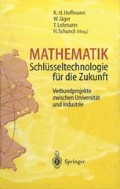Abstract
The present paper reports on a joint project of the IWR, the robot manufacturing company KUKA GmbH, Augsburg, and the CAD system developer Tecnomatix GmbH, Dietzenbach. The work aims at developing mathematical tools for off-line programming and trajectory optimization based on dynamic robot models in order to improve both the accuracy of off-line programming and the resulting cycle times of production lines. We address the issues of dynamic robot modeling, calibration and, in more detail, trajectory optimization. Optimization results for an industrial robot KUKA IR761 performing a real-life transport maneuver show that substantial reductions of the cycle time can be achieved.
Weitere Autoren: V. H. Schulz und R. W. Longman, Deptartment of Mechanical Engineering, Columbia University, New York, New York 10027, USA.
Access this chapter
Tax calculation will be finalised at checkout
Purchases are for personal use only
Preview
Unable to display preview. Download preview PDF.
Literatur
American Institute of Aeronautics and Astronautics. Proceedings of the 1989 AIAA Guidance, Navigation and Control Conference, Boston, MA, 1989.
R. Bernhardt and S. L. Albright, editors. Robot Calibration. Chapman & Hall, 1993.
H. G. Bock. Recent advances in parameteridentification techniques for O.D.E. In P. Deuflhard and E. Hairer, editors, Numerical Treatment of Inverse Problems in Differential and Integral Equations, volume 2 of Progress in Scientific Computing. Birkhäuser, Boston, 1983.
H. G. Bock. Randwertproblemmethoden zur Parameteridentifizierung in Systemen nichtlinearer Differentialgleichungen. Dissertation, Bonner Mathematische Schriften 183, Universität Bonn, 1987
H. G. Bock and K. J. Plitt. A multiple shooting algorithm for direct solution of constrained optimal control problems. In Proceedings of the 9th IF AC World Congress, pages 242–247, Budapest, Hungary, 1984. Pergamon Press.
J. Hilsebecher. Vermessung von räumlichen Trajektorien zur kinematischen Kalibration von Robotern. Diplomarbeit, Universität Heidelberg, 1995.
K.-D. Hilf. Optimale Versuchsplanung zur dynamischen Roboterkalibrierung. Dissertation, Universität Heidelberg, 1996.
J. Konzelmann. Numerische Berechnung zeitoptimaler Steuerungen von Industrierobotern mit direkt optimierenden RWP-Methoden. Diplomarbeit, Universität Bonn, 1988.
J. Konzelmann, H. G. Bock, and R. W. Longman. Time optimal trajectories of elbow robots by direct methods. In AIAA [AIA], pages 883–894.
J. Konzelmann, H. G. Bock, and R. W. Longman. Time optimal trajectories of polar robot manipulators by direct methods. Modeling and Simulation, 20(5):1933–1939, 1989.
M. Mössner-Beigel. Optimale Steuerung für Industrieroboter unter Berücksichtigung der getriebebedingten Elastizität. Diplomarbeit, Universität Heidelberg, 1995.
K.-J. Plitt. Ein superlinear konvergentes Mehrzielverfahren zur direkten Berechnung beschränkter optimaler Steuerungen. Diplomarbeit, Universität Bonn, 1981.
B. Schietz. Hochgenaue bildverarbeitende Meßverfahren in der dynamischen Roboterkalibrierung. Diplomarbeit, Universität Heidelberg, 1995.
J. P. Schlöder. Numerische Methoden zur Behandlung hochdimensionaler Aufgaben der Parameteridentifizierung. Dissertation, Bonner Mathemati sche Schriften 187, Universität Bonn, 1988.
V. H. Schulz. Ein effizientes Kollokationsverfahren zur numerischen Behandlung von Mehrpunktrandwertaufgaben in der Parameteridentifizierung und Optimalen Steuerung. Diplomarbeit, Universität Augsburg, 1990.
V. H. Schulz. Reduced SQP Methods for Large-Scale Optimal Control Problems in DAE with Application to Path Planning Problems for Satellite Mounted Robots. Dissertation, Universität Heidelberg, 1996.
V. H. Schulz, H. G. Bock, and M. C. Steinbach. Exploiting invariants in the numerical solution of multipoint boundary value problems for DAE. SIAM Journal on Scientific Computing. To appear.
R. von Schwerin and M. Winckler. MBSSIM—a guide to an integrator library for multibody systems simulation, version 1.00. Technical Report 94–75, IWR, Universität Heidelberg, December 1994.
M. C. Steinbach. Numerische Berechnung optimaler Steuerungen für Industrieroboter. Diplomarbeit, Universität Bonn, 1987.
M. C. Steinbach. A structured interior point SQP method for nonlinear optimal control problems. In R. Bulirsch and D. Kraft, editors, Computational Optimal Control, volume 115 of International Series of Numerical Mathematics, pages 213–222. Birkhäuser, Basel, 1994.
M. C. Steinbach. Fast Recursive SQP Methods for Large-Scale Optimal Control Problems. Dissertation, Universität Heidelberg, 1995.
M. C. Steinbach. Structured interior point SQP methods in optimal control. Submitted to Zeitschrift für Angewandte Mathematik und Mechanik, Special Issue Part 1: Applied Stochastics and Optimization. (Proceedings of ICIAM 95, Hamburg, Germany), 1995.
M. C. Steinbach, H. G. Bock, and R. W. Longman. Time-optimal extension or retraction in polar coordinate robots: A numerical analysis of the switching structure. In AIAA [AIA], pages 895–910.
M. C. Steinbach, H. G. Bock, and R. W. Longman. Time optimal control of SCARA robots. In Proceedings of the 1990 AIAA Guidance, Navigation and Control Conference, pages 707–716, Portland, OR, 1990. American Institute of Aeronautics and Astronautics.
M. C. Steinbach, H. G. Bock, and R. W. Longman. Time-optimal extension and retraction of robots: Numerical analysis of the switching structure. Journal of Optimization Theory and Applications, 84(3):589–616, 1995.
B. Wolf. Numerische Bahnoptimierung von Robotern unter Berücksichtigung der Gelenkreibung. Diplomarbeit, Universität Heidelberg, 1995.
Author information
Authors and Affiliations
Editor information
Editors and Affiliations
Rights and permissions
Copyright information
© 1997 Springer-Verlag Berlin Heidelberg
About this paper
Cite this paper
Bock, H.G., Schlöder, J.P., Steinbach, M.C., Wörn, H. (1997). Schnelle Roboter am Fließband: Mathematische Bahnoptimierung in der Praxis. In: Hoffmann, KH., Jäger, W., Lohmann, T., Schunck, H. (eds) Mathematik Schlüsseltechnologie für die Zukunft. Springer, Berlin, Heidelberg. https://doi.org/10.1007/978-3-642-60550-5_44
Download citation
DOI: https://doi.org/10.1007/978-3-642-60550-5_44
Publisher Name: Springer, Berlin, Heidelberg
Print ISBN: 978-3-642-64453-5
Online ISBN: 978-3-642-60550-5
eBook Packages: Springer Book Archive

